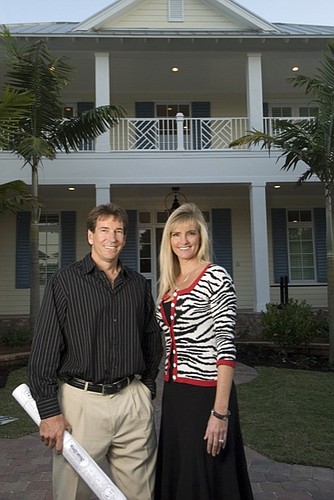Bill Weber designed a home in South Korea, but he's never seen the site and he doesn't plan to travel there.
Besides, the owner doesn't want him there anyway. The home Weber designed is for an undisclosed high-ranking government official, with escape routes from the master bedroom and an underground four-car garage accessible via a secret tunnel.
Like other businesses feeding off the housing boom in Naples, Bill Weber, 45, and his wife, Kerry Weber, 42, built Weber Design Group into a thriving operation, designing multi-million-dollar homes in tony neighborhoods such as Port Royal.
There was so much work in Naples that the Webers weren't interested in jobs beyond Southwest Florida. Financial security was on the horizon. “We thought retirement was in the bag,” Bill Weber says.
But as the recession halted new-home construction, the Webers realized they had to expand their reach way beyond Florida's borders. Today, as much as 40% of their business comes from overseas (they decline to cite the firm's revenues).
That international business hasn't replaced the lost revenues from the downturn, which forced the Webers to pare their staff down to five full-time people now. However, it has allowed them to survive through these last few brutal years.
Turns out that popular designs for multi-million-dollar houses in Naples are in demand elsewhere in the world. “Growing up in this area, I didn't realize how fortunate I was,” Weber says.
After all, Naples has one of the highest concentrations of multi-million-dollar homes. During the height of the boom, the median home price in the Naples area exceeded $500,000.
As a result, the Webers and a handful of other designers and architects have intimate knowledge of what super-wealthy individuals want in homes that can measure as big as 15,000 square feet.
When wealthy tourists come to Naples, they want to replicate what they've seen but are often unable to find architects in their home countries who are capable of such work. “It's a breeding ground of successful industry people, from great designers to architects and tradesmen,” Weber says.
But the international buyers are hard to market to, the countries they live in may be unstable and building rules may differ substantially from the U.S. Of course, language is a barrier too. “Diversification is a monster,” Bill Weber says.
The South Korean customer's personal builder found Weber at an international builder's show in Orlando. The builder's son lived in New York and acted as the translator.
In most cases, foreign clients come to the Webers from local referrals. They see a Weber-designed home and want to replicate it in their home country.
In some cases, leads come from the firm's Web site. Here's the challenge for Kerry Weber, who screens the inquiries: “You just don't know who's on the other end,” she says.
Sometimes, foreigners who request information aren't legitimate. “Every couple of months we get people who waste our time,” Kerry Weber says. “I don't get mad,” Bill Weber, says, adding he and Kerry Weber have gotten good at sniffing out impostors. “It's just part of doing business.”
But closing a deal with a foreign buyer is much more difficult. If the customer is local, the Webers say they can close a deal eight out of 10 times. With foreigners, it's two out of ten inquiries.
Sometimes that's because foreigners are accustomed to haggling for a better price. “I don't negotiate,” Bill Weber says flatly. “I can't stand it.”
What's more, the client often has to do the homework before Weber will start a design. “I ask the client to do the due diligence,” Weber says. “Sometimes clients get aggravated.”
He requests building regulations translated into English, recommendations for local architects and engineers he can collaborate with and photos of the site. He uses the mapping service Google Earth extensively and that keeps his costs down because he doesn't have to travel to the site. Advance preparation is key because mistakes eat into profits, Weber says. “I pay attention to that,” he says.
Weber, whose average job costs $50,000 to $60,000, requests payment up front from his customers and asks for additional funds to pay for translators and engineers he subcontracts.
In his contracts, he includes provisions that account for the possibility that government permitting might be challenging, such as the case of a 7,500-square-foot home he's designing for a client in Denmark. By their standards, that size is palatial.
But the diversification is crucial for survival, Weber says. And he hopes business this year will grow 10% to 15%. “I've got a bunch of ex-employees that I want to put to work,” he says.






